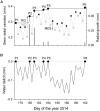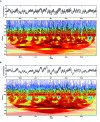Tree water status and growth of saplings and mature Norway spruce (Picea abies) at a dry distribution limit
- PMID: 26442019
- PMCID: PMC4561357
- DOI: 10.3389/fpls.2015.00703
Tree water status and growth of saplings and mature Norway spruce (Picea abies) at a dry distribution limit
Abstract
We evaluated the size effect on stem water status and growth in Norway spruce (Picea abies (L.) Karst.) occurring at the edge of its natural range in a dry inner Alpine environment (750 m asl, Tyrol, Austria). Intra-annual dynamics of stem water deficit (ΔW), maximum daily shrinkage (MDS), and radial growth (RG) were compared among saplings (stem diameter/height: 2.2 cm/93 cm; n = 7) and mature adult trees (25 cm/12.7 m; n = 6) during 2014. ΔW, MDS, and RG were extracted from stem diameter variations, which were continuously recorded by automatic dendrometers and the influence of environmental drivers was evaluated by applying moving correlation analysis (MCA). Additionally, we used Morlet wavelet analysis to assess the differences in cyclic radial stem variations between saplings and mature trees. Results indicate that saplings and mature trees were experiencing water limitation throughout the growing season. However, saplings exhibited a more strained stem water status and higher sensitivity to environmental conditions than mature trees. Hence, the significantly lower radial increments in saplings (0.16 ± 0.03 mm) compared to mature trees (0.54 ± 0.14 mm) is related to more constrained water status in the former, affecting the rate and duration of RG. The wavelet analysis consistently revealed more distinct diurnal stem variations in saplings compared to mature trees. Intra-annual RG was most closely related to climate variables that influence transpiration, i.e., vapor pressure deficit, relative air humidity, and air temperature. MCA, however, showed pronounced instability of climate-growth relationships, which masked missing temporal or significant correlations when the entire study period (April-October) was considered. We conclude that an increase in evaporative demand will impair regeneration and long-term stability of drought-prone inner Alpine Norway spruce forests.
Keywords: Picea abies; dendrometer; dry inner Alpine valley; maximum daily shrinkage; radial growth; stem water deficit; wavelet analysis.
Figures







References
-
- Anfodillo T., Rento S., Carraro V., Furlanetto L., Urbinati C., Carrer M. (1998). Tree water relations and climatic variations at the alpine timberline: seasonal changes of sap flux and xylem water potential in Larix decidua Miller, Picea abies (L.) Karst. and Pinus cembra L. Ann. For. Sci. 55 159–172.
-
- Betsch P., Bonal D., Breda N., Montpied P., Peiffer M., Tuzet A., et al. (2011). Drought effects on water relations in beech: the contribution of exchangeable water reservoirs. Agric. For. Meteorol. 151 531–543. 10.1016/j.agrformet.2010.12.008 - DOI
Grants and funding
LinkOut - more resources
Full Text Sources
Other Literature Sources
Research Materials
Miscellaneous

